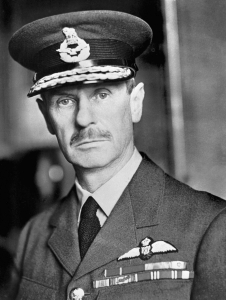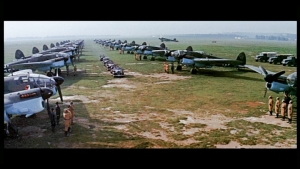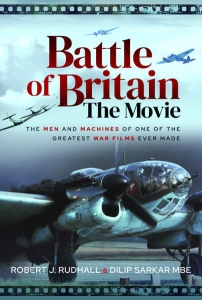Director: Guy Hamilton
Producer: Harry Saltzman
Script: James Kennaway. Wilfred Greatorex
A common legend among the British is the trope of a “small bunch of British men against the might of the ugly bad …….. ” . In the blanks, you can insert Africans (Zulu and Khartoum), Pathans and Indians (Gunga Din, The Bengal Lancers), the Oriental hordes (55 days at Peking) or the perennial favourites – The Germans. Needless to say, there is only one kind of “The Germans” – The Nazis.
Real and Reel life is full of films about a last British “gallant stand”. Some of these films were grandiose projects, and very few were authentic. However, the movie The Battle of Britain is probably the most authentic on-screen depiction of a real-life story of the British standing alone, with nothing to prevent a Nazi invasion of Britain. Except the British Air Force and its plucky band of gallant fighter pilots. The Few who have passed from history into Legend.

September 15 is an almost “Holy Day” for most British as on that day, 83 years ago, the Royal Air Force finally “defeated” the German Luftwaffe and its plans to dominate British skies. To call it a “battle” is a misleading term. It’s not a single battle on a single day or location. It’s more like a campaign that started in July 1940, took a decisive turn in September 1940 and spluttered onwards ineffectually from October 1940. The Royal Air Force (RAF) ‘saved” Britain that day.
To enjoy the film, it is essential to understand what happened. Otherwise, it would be just a bunch of planes filling the screen all the time.
By June 1940, the Germans had captured Western and Northern Europe. Neutrality meant nothing to Hitler as he occupied neutral Norway and Holland. Denmark, Belgium and France were the next to be occupied. The British Army and its French Allies fought a desperate rearguard action at Dunkirk, while Operation Dynamo evacuated about 400,000 British and French troops from the beaches and port of Dunkirk. Winston Churchill called it The Miracle of Dunkirk but also famously said that retreats do not win battles. All that stood between the rampaging Germans and the British was the Sea, dominated by the Royal Navy. If Britain had to be invaded, the Germans needed absolute air supremacy, as they had in their lighting offensives over Western Europe and Poland.
Hermann Goering, the head of the Luftwaffe, promised that a seaborne invasion would be unnecessary as “my air force could do the job”. Hitler believed him and even offered the British an olive branch. An ardent admirer of the British Empire and how it created its colonies to feed its “mother country”, Hitler proposed that he would leave the British Empire alone in exchange for being given a free hand in the rest of Europe, especially against the Soviet Union whose vast natural resources were his target and which guaranteed the “lebensraum” for the “German Empire”.
That was the historical background against which The Battle of Britain happened over four gruelling months from July 1940 to October 1940.
The German Luftwaffe, confident after its lightning successes in Europe, now faced a determined foe who stood alone and called upon the resources of its Empire. Volunteers from German-occupied countries like France, Poland, Czechoslovakia, Belgium, etc., who had fled to Britain, formed special squadrons in the RAF. Some squadrons, especially the Poles, saw action in the Battle of Britain.

The Germans were working at a disadvantage. The Germans had never focused on a long-range strategic force. Their aircraft always had “short legs’. The famed Me109 fighter had only about 20 minutes of “fighting time” over England. In contrast, the British Spitfires and Hurricanes, had the advantage of “home ground”. They could land and refuel and fly back as many times as they wanted, to attack the German bombers, while the German fighter escorts always had to keep one eye on the fuel gauge and another on the overall tactical situation. This lesson would be painfully learned, at a high cost, by the British and Americans during the Allied bombings of Germany from 1942-1944. Now, the Allied fighters didn’t have the range to escort the bombers to Germany and back, much like the German fighters in 1940 (until the arrival of the P51 Mustang which changed everything and gave Allied Air Supremacy from mid-1944).
The British had another major secret. Their excellent radar network of Chain High and Chain Low stations covered almost all routes to Britain across the southern and East coasts. No enemy aircraft could penetrate British airspace without being quickly identified. ULTRA was unknown when the film was made, and its effects were not woven into the story. ULTRA was simple – the British were decoding all German communications and could decide when and where to parcel their fighters in small packets.
It was a touch-and-go campaign as, at one stage, almost all British fighter reserves were simultaneously in the air. They couldn’t have coped with another crippling German blow. On seeing these new Reserves join the fight, the Germans wrongly concluded that the British had more Reserves and that their intelligence estimates of British strength had been hopelessly wrong.
Initially, the Germans stuck to attacking British military targets. Due to a navigational error, one bomber lost its way and accidentally bombed London. A furious Churchill ordered a retaliation raid on Berlin. An equally furious Hitler then shifted the entire might of the German forces to bombing London by day and night – the famous Blitz of late 1940 – thus giving a reprieve to the much-harassed overall commander of Fighter Command, Air Marshal Hugh Dowding. Dowding and his fighter pilots could now harass the bombers to and from London in a phased manner, while earlier, all their airfields, oil depots and radar stations had been repeatedly bombed, leaving some inoperative. From a worrying situation, this German mistake turned the campaign in British favour. Goering had boasted “If planes drop bombs on Germany, you can call me Meier”. Naturally behind his back his colleagues and the population started saying so.
Why is this history important? Simple. All these events are presented as composite events in this brilliantly made 1969 film with a galaxy of English and German stars. Michael Caine, Edward Fox, Robert Shaw, Christopher Plummer, and Susannah York – all the famous stars of the 1960s – have brief roles as various (composite) characters. It is Laurence Olivier and Trevor Howard as Hugh Dowding and Keith Park, the two architects of the victory, who have well-written roles, befitting the people who were directly responsible for the victory and were shoddily shunted aside because of military politics. They were given their rightful due as the architects of the Victory long after the war.
The film starts and ends with Dowding contemplating the events. In the beginning, Hugh Dowding (below left) – a simply superb Laurence Olivier (below right) – reflects his dwindling forces when he writes a memo to Churchill. In the end, Dowding looks at the blue, “German free” skies, and we see the famous Churchill quote “, Never in the field of Human Conflict has so much been owed by so many to so Few”.


The fighter pilots – as already mentioned – became forever The Few.
Shooting any war film is a headache in itself. But shooting a movie on an air battle? In a land battle, there are actual “physical” “locations”, while in an air (or naval) battle, there are none. Can one part of the “sky” compare to that fateful “sky” of 1940? Can the old airfields still look like what they were in 1940? Can the old Spitfires, Hurricanes, Me109s, and He111s be resurrected and flown again?
The last was easier said than done. However, by a stroke of luck, the Spanish Air Force was still flying their license-made copies of the Me109 called Buchon and the Casa 111. The British planes were scoured from all over the world. The air-to-air action was filmed by a “camera mother plane”, which had multiple cameras in various locations in its fuselage to give the film an immediate “air action” look and feel. The meticulous attention to detail is evident in how the entire “battle” unfolds. Having leading stars play composite characters “anchors” our attention and action to them while the more significant battle unfolds in the background.

The event of three months is presented in an engrossing two-and-a-half-hour, historically accurate film with the required star power and some authentic edge-of-the-seat action and is beautifully produced and directed. The complex script simplifies but doesn’t dumb down the three-month-long action into an absorbing watch.
Producer Harry Saltzman’s stock was up due to his “Harry Palmer” and “James Bond” productions. The same lavish attention to detail was evident in various settings, locales and even the wooden models that are blown up in multiple scenes as they have the 1940 vintage markings and camouflage. The “radar plots” in the Sector Control Centre are an earlier “analogue’ form of the large screen “digital” display so familiar to modern viewers.

The film was free to watch on YouTube but is no longer available. It is, however, available on Amazon Prime.
Some of the “making of” videos will give you an idea of how it was old-fashioned filmmaking without any CGI or special effects that created the “armada” of fighters and bombers on both sides. Some of these videos are as follows:
A production short voiced by Michael Caine
Another one about the filming
Michael Caine explains the history of the film and its production. At 9:20, Laurence Oliver explains to Hugh Dowding, “I am pretending to be you and making a right mess of it”, to which the ailing Dowding replies to all-round laughter, “I am sure”. Guy Hamilton also explains some of the historical background of the film and how he tried to do justice to it

There is also a book about how the film was made. It is no less than an adventure story. Details how the crew, planes, and script were all rounded up and how the film was made.
In sum, it is one of those rare war films that almost scores a perfect five. Accurate and entertaining .
Script – 5 out of 5
Story – 4 out of 5
Direction – 5 out of 5
Photography – 5 out of 5
Total – 4.8 out of 5
Leave a Reply
Want to join the discussion?Feel free to contribute!